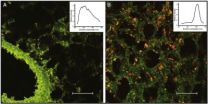(Press-News.org) PROVIDENCE, R.I. [Brown University] — The rate at which lead poisoning has struck young Rhode Island children depends heavily on where they live, according to a Brown University-led geographic analysis of comprehensive health department data from across Rhode Island between 1993 and 2005. By mapping cases of lead poisoning, researchers have been able to help target cleanup resources to do the most good.
During that 12-year period, some census blocks in the state had no cases of poisoning in the study group of 204,746 children, but in the hardest hit census blocks of Providence, Pawtucket, Central Falls, Woonsocket, and Newport, lead poisoning afflicted as many as 48.6 percent of kids under 6.
Patrick Vivier, associate professor of community health and pediatrics and lead author of the study, said that although he has been familiar with the state's fight against lead poisoning for years, he was still struck by the geographic and demographic disparities uncovered in the analysis published online Oct. 23 by the Maternal and Child Health Journal.
"We know there are disparities, but to look at zero cases in some areas and almost 50 percent in some areas is still shocking," said Vivier, who is also affiliated with Hasbro Children's Hospital and Rhode Island Hospital.
Although the trend over time has been that lead poisoning cases are declining, that does not mean the problem's impact has dissipated. The damage lead can do to a child's developing nervous system is irreversible. In hard-hit areas, a generation of children has been at high risk for suffering symptoms such as behavioral disorders and reduced attention span and IQ scores.
Pinpointing poisoning
According to the study of state health department mandated test results, the risk of a child being poisoned by lead was four times higher than average for children living in the state's poorest neighborhoods, and just under three times higher for children living in a neighborhood with a preponderance of pre-1950 housing. Sometimes those areas overlapped, but even accounting for that overlap, each factor independently and significantly heightened the risk kids faced.
Viewed on maps, the data make a clear case that lead poisoning is a much greater problem in some very specific areas of the state than in others, Vivier said. This insight has allowed a commission formed by Attorney General Patrick Lynch to recommend the best places to spend millions of dollars of cleanup money provided by DuPont after years of protracted litigation by the attorney general against several chemical companies and paint manufacturers.
The commission used the data to map the neighborhoods that had the highest poverty, the highest stock of pre-1950 housing and the highest frequency of lead poisoning, and focused the efforts there.
"We know where to go," Vivier said. "These places are clustered in specific spots so it means we can go and do something about it in those places."
Cleanup efforts around the state funded by the Du Pont money are still going on.
Rhode Island's mandatory program of testing for lead poisoning and the Rhode Island Department of Health's statewide lead database have provided an unusually rich record of data, Vivier said. But looking at the striking sociological disparities in the data, as well as its usefulness in mapping those disparities, Vivier said public health researchers should be eager to apply geographic analysis in other such studies.
"This paper demonstrates the huge health burden that where you live can have," Vivier said.
###In addition to Vivier, the study's other authors were Sherry Weitzen, research assistant professor of community health; John Logan, professor of sociology; Marissa Hauptman of New York University Medical School; Scott Bell, associate professor of geography at the University of Saskatchewan; and Daniela Quilliam of the Rhode Island Department of Health.
The study was funded by Brown University, including money received from Du Pont as part of an agreement between the company and state Attorney General Patrick Lynch.
END
COLD SPRING HARBOR, N.Y. (Mon., Nov. 1, 2010) -- Imaging has rapidly become a defining tool of the current era in biological research. But finding the right method and optimizing it for data collection can be a daunting process, even for an established imaging laboratory. Cold Spring Harbor Protocols is one of the world's leading sources for detailed technical instruction for implementation of imaging methods (http://cshprotocols.cshlp.org/cgi/collection/imaging_microscopy_general), and the November issue (http://cshprotocols.cshlp.org/TOCs/toc11_10.dtl) features articles ...
PITTSBURGH, Nov. 1 – Nonsteroidal anti-inflammatory drugs (NSAIDs) prevent colon cancer by triggering diseased stem cells to self-destruct, according to researchers at the University of Pittsburgh Cancer Institute (UPCI) and the University of Pittsburgh School of Medicine. Their findings, reported in the early online version of this week's Proceedings of the National Academy of Sciences, could lead to new strategies to protect people at high risk for the disease.
Doctors have long known that NSAIDs, such as aspirin, can lower the risk of colon cancer, but it's not been ...
NEW BRUNSWICK, N.J. – An international team of scientists led by Rutgers University astrophysicists have discovered 10 new massive galaxy clusters from a large, uniform survey of the southern sky. The survey was conducted using a breakthrough technique that detects "shadows" of galaxy clusters on the cosmic microwave background radiation, a relic of the "big bang" that gave birth to the universe.
In a paper published in the Nov. 10 issue of Astrophysical Journal, the Rutgers scientists and collaborators at the Pontifical Catholic University of Chile (PUC) describe their ...
Inappropriate growth and survival signaling, which leads to the aberrant growth of cancer cells, is a driving force behind tumors. Much of current cancer research focuses on the kinase enzymes whose mutations are responsible for such disregulated signaling, and many successful molecularly targeted anti-cancer therapeutics are directed at inhibiting kinase activity.
Now, UCLA researchers from the Crump Institute for Molecular Imaging, the Institute for Molecular Medicine, the California NanoSystems Institute, the Jonsson Comprehensive Cancer Center and the department ...
COLUMBUS, Ohio – New research suggests that the addition of ultraviolet light to the brushing and suction of a vacuum cleaner can almost double the removal of potentially infectious microorganisms from a carpet's surface when compared to vacuuming alone.
Researchers say the findings suggest that incorporating the germicidal properties of UV light into vacuuming might have promise in reducing allergens and pathogens from carpets, as well.
"What this tells us is there is a commercial vacuum with UV technology that's effective at reducing surface microbes. This has promise ...
BUFFALO, N.Y. -- Researchers at the University at Buffalo have developed a novel technology using quantum dots that is expected to have major implications for research and treatment of tuberculosis, as well as other inflammatory lung diseases.
A paper appearing online in Nanomedicine: Nanotechnology, Biology and Medicine as an article-in-press describes specific delivery of a chemotherapeutic drug to specific cells in the lung, particularly the alveolar white cell, without causing acute inflammation.
Quantum dots are tiny semiconductor particles generally no larger ...
Washington, November 1, 2010 – Elderly women are at high risk for inappropriate urinary catheter utilization in emergency departments, according to a new study in the November issue of the American Journal of Infection Control, the official publication of the Association for Professionals in Infection Control and Epidemiology (APIC).
The study was conducted at St John Hospital and Medical Center, a 769-bed tertiary care teaching hospital in Detroit, Mich. The authors examined 532 instances in which urinary catheters were placed in emergency room patients over a 12-week ...
Along with energy conservation and storm-water reduction, scientists may soon be adding crime-fighting to the list of benefits that urban trees provide. Researchers with the U.S. Forest Service's Pacific Northwest (PNW) and Southern Research Stations have published a new study that suggests that certain types of city trees may help lower property and violent crime rates. Their study—which is posted online in advance of its appearance in a forthcoming printed issue of the journal Environment and Behavior—is the first to examine the effects of trees and other factors on crime ...
COLUMBIA, Mo. – It may seem difficult to change stereotypical thinking. Perceptions can be very important in forming an individual's attitudes. Now, researchers at the University of Missouri have found that people conditioned to think in opposition to racial stereotypes are more receptive to people from minority groups starring in commercial advertising.
Saleem Alhabash, a doctoral candidate in the University of Missouri School of Journalism.
"This research shows that when people are trained to think in a non-stereotypical way, they will pay more attention to ads with ...
GMOs, or Genetically Modified Organisms, may raise concerns of genes escaping from crops and having unknown effects on natural, wild species. But what is the real risk that traits associated with GMOs will actually migrate to and persist in their wild relatives? Interest in plant ecology, crop production and weed management led John Lindquist and his colleagues from the University of Nebraska and USDA-ARS to investigate how gene flow from a cultivated crop to a weedy relative would influence the ecological fitness of a cropwild hybrid offspring. They published their findings ...


